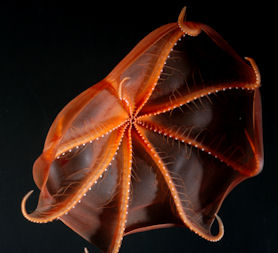Marine census discovers unknown ocean species
A major census of the marine life in the world’s oceans – the culmination of 10 years of exploration – reveals previously-unknown species.

It used to be a cliché that we knew more about the surface of the Moon that we do about the oceans on our own planet. After a decade of work by thousands of marine scientists we can now say we have a much better understanding of life in the water that covers 70 per cent of the Earth.
The Census of Marine Life is nothing less than a Domesday Book of the oceans. More than 540 expeditions, with research by 2,700 scientists from 80 nations, has revealed an extraordinary web of life, from the coastal shallows to the deepest ocean trench.
From microbes to whales, from the icy poles to the warm tropics, they found an unprecedented abundance of marine life, including 6,000 new species.
They predict there may be as many as 750,000 new marine species yet to be discovered.
Everywhere they looked they found marine life. Even in the most extreme of habitats, at hydro-thermal vents where molten rock spewing on to the ocean floor to make new continental crust heats the water to hundreds of degrees; at places so cold sea water freezes; where there’s no light and no oxygen, they found life. In the oceans, extreme is normal.
Unexpectedly, on the sea floor, they found the quantity of life peaks towards the polar regions; on the margins of the deep sea they found huge mats of bacteria and undiscovered coral reefs extending out for hundreds of kilometres.
And most marine life is microbial, by weight, some 90% of what’s in the oceans.
See more about our changing natural world at our Special Reports on climate change
Plotting migration
Setting out ten years ago to answer the questions: “what’s there?”, “where is it?” and “how many?”, the Census has brought answers that reveal where marine life is at its most diverse – the coastal waters of the tropical West Pacific. They tracked thousands of fish and animals as they migrated, plotting the marine highways they used between the main oceans, or as they commuted daily from the surface to the depths hundreds of metres down. They watched as millions of fish assembled into giant shoals as large as Manhattan Island.
And yet, for more than 20 per cent of the oceans’ volume they still have no records at all and for vast areas very few.
They predict there may be as many as 750,000 new marine species yet to be discovered.
But their research revealed too how mankind and climate change is altering the oceans. The phyto-plankton that swim near the surface are declining globally. They are the bottom of the food chain for everything that lives in the seas. The scientists counted the decline in numbers and size of sea creatures from over-fishing and habitat destruction. Yet they found too that some species are recovering.
The Census means we now have a baseline to help the world understand what’s needed to conserve the extraordinary biodiversity of the oceans. From international fishing agreements to understanding the impact of oil spills, the Census of Marine Life will underpin future decisions on the way we use – and abuse – the waters of Planet Earth.